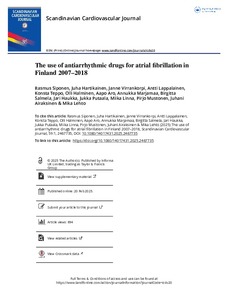The use of antiarrhythmic drugs for atrial fibrillation in Finland 2007–2018
Siponen, Rasmus; Hartikainen, Juha; Virrankorpi, Janne; Lappalainen, Antti; Teppo, Konsta; Halminen, Olli; Aro, Aapo; Marjamaa, Annukka; Salmela, Birgitta; Haukka, Jari; Putaala, Jukka; Linna, Miika; Mustonen, Pirjo; Airaksinen, Juhani; Lehto, Mika
https://urn.fi/URN:NBN:fi-fe2025082790122
Tiivistelmä
Background
Patients with atrial fibrillation (AF) are often treated with antiarrhythmic drugs (AADs) to maintain sinus rhythm and with heart rate-lowering drugs to achieve the optimal rate control. In this study, we investigated trends in the use of AADs and rate control drugs in Finnish patients with AF.
Methods and results
The Finnish AntiCoagulation in Atrial Fibrillation (FinACAF) study is a nationwide study including all patients with AF in Finland from 2007 to 2018. The number of AAD purchases and the proportions of all prevalent AF patients in a certain year of interest were calculated. In total, 391030 AF patients were identified between 2007 and 2018, and 39,816 (10.2%) of them had purchased either class I or III AADs. The proportion of patients using classes I and III AADs decreased from 8.6% to 6.3%. Flecainide and amiodarone were the most often used AADs. The use of flecainide and amiodarone decreased from 4.9% to 3.9% and 1.9% to 1.5%, respectively. The proportion of patients on beta-blockers remained stable at 75%. Dronedarone became available in 2011 when it also was the most used (0.8% of patients), but the use decreased thereafter. The use of sotalol and digoxin decreased from 1.5% to 0.6% and 24.6% to 11.0% over the study period.
Conclusion
The number of AAD purchases increased alongside with the increasing prevalence of AF, whereas the proportion of AF patients on classes I and III AADs and digoxin decreased between 2007 and 2018. Flecainide remained the most used AAD followed by amiodarone.
Kokoelmat
- Rinnakkaistallenteet [27094]
